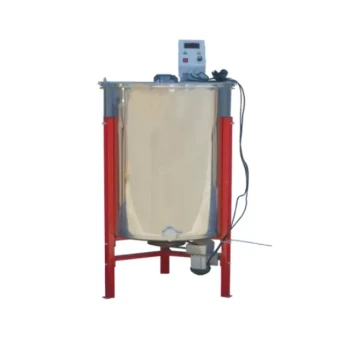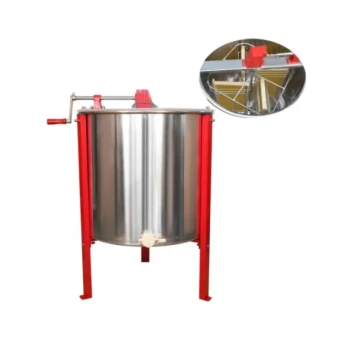The primary difference between tangential and radial honey extractors is the orientation of the frames inside the drum. This single design choice dictates whether honey is extracted from one side at a time or from both sides simultaneously. A tangential extractor holds frames with one side of the honeycomb facing the wall, requiring you to manually flip them halfway through the process. A radial extractor positions frames vertically like spokes on a wheel, using centrifugal force to draw honey from both sides at once.
While the mechanical difference is simple frame placement, the practical implication is profound: radial extractors are built for speed and volume, making them the standard for larger operations, whereas tangential extractors are simpler and often better suited for small-scale hobbyists.

How Each Extractor Works
To understand the practical differences, it's essential to visualize how each design uses centrifugal force.
The Tangential Method: One Side at a Time
In a tangential extractor, the frames are placed in a cage with the broad side of the honeycomb facing outward, parallel to the extractor's wall.
When the basket spins, honey is slung from the outer-facing side of the comb. To extract from the other side, you must stop the machine, turn each frame around, and then spin it again.
This method is most common in smaller, more affordable extractors and is mechanically simpler.
The Radial Method: Maximum Efficiency
A radial extractor orients the frames with the top bar facing the wall, like the spokes of a wheel extending from a central hub.
As the basket spins, honey is pulled from the cells on both sides of the comb simultaneously. The outward force works with the natural upward slope of the honeycomb cells.
This design eliminates the need to flip frames, drastically reducing labor and speeding up the entire extraction process.
The Critical Distinction: Power Source vs. Extraction Method
It's common for beekeepers to confuse the extraction method with the power source, but they are two separate decisions.
Extraction Method (The "How")
This refers to the physics of honey removal. Your choice here is between tangential (one side) and radial (both sides).
Power Source (The "Driver")
This refers to what spins the basket. Your choice is between manual (a hand crank) and motorized (an electric motor).
Why This Matters
While you can find all combinations, certain pairings are far more common. Most entry-level, hobbyist extractors are manual tangential extractors. Conversely, nearly all large-scale, commercial-grade machines are motorized radial extractors because the goal is maximum efficiency.
Understanding the Trade-offs
Choosing between these designs involves balancing cost, efficiency, and the scale of your operation.
Speed and Labor
A radial extractor is significantly faster. By eliminating the step of flipping frames, it saves immense time and physical effort, especially when processing a large number of supers.
A tangential extractor is inherently more labor-intensive due to the start-stop-flip-start process required for every batch.
Comb Integrity
The radial design is generally considered gentler on the honeycomb. Because force is applied evenly outward from the central axis, there is less risk of "blowing out" the comb structure, particularly with delicate new comb.
Tangential extractors can place more direct stress on the side of the comb facing inward, which can lead to damage if spun too aggressively at the start.
Capacity and Cost
Tangential extractors are typically smaller, hold fewer frames, and are much more affordable. This makes them an excellent entry point for new beekeepers with only a few hives.
Radial extractors are designed to hold many more frames. This larger capacity and more complex engineering mean they come at a higher price point, representing an investment in operational efficiency.
Making the Right Choice for Your Apiary
Your decision should be guided by the current size and future goals of your apiary.
- If your primary focus is hobby beekeeping (1-4 hives): A manual tangential extractor offers the best balance of low cost and functionality for a small number of frames.
- If your primary focus is growing your operation (5-20+ hives): A motorized radial extractor is a necessary investment that will save you significant time and prevent extraction day from becoming an exhausting chore.
- If your primary focus is processing honey quickly and with minimal effort: The efficiency of a radial extractor is unmatched, making it the clear choice for any serious sideliner or commercial beekeeper.
Ultimately, choosing the right extractor is about aligning the equipment's efficiency with the scale and ambition of your beekeeping journey.
Summary Table:
| Feature | Tangential Extractor | Radial Extractor |
|---|---|---|
| Frame Orientation | One side faces wall | Frames like spokes on a wheel |
| Extraction Process | One side at a time; must flip frames | Both sides simultaneously |
| Best For | Hobbyists (1-4 hives) | Sideliners & Commercial (5+ hives) |
| Speed & Labor | Slower, more labor-intensive | Faster, less manual effort |
| Typical Cost | Lower | Higher (investment in efficiency) |
| Comb Integrity | Higher risk of damage if spun too fast | Gentler on the honeycomb |
Ready to Scale Your Honey Harvesting Efficiency?
Choosing the right extractor is a critical step in growing your apiary. Whether you're a hobbyist needing a reliable tangential model or a commercial beekeeper requiring the speed of a radial machine, HONESTBEE has the equipment to match your ambition.
We supply durable, high-performance beekeeping supplies and equipment through wholesale-focused operations, perfect for commercial apiaries and distributors. Let us help you find the perfect extractor to save time and increase your honey yield.
Contact HONESTBEE today for expert advice and wholesale pricing!
Visual Guide

Related Products
- Stainless Steel Manual 8 Frame Radial Honey Extractor Machine for Beehives
- HONESTBEE 72 Frame Industrial Electric Honey Extractor for Beekeeping
- 8-Frame Electric Self-Reversing Honey Extractor Spinner for Commercial Honey Extraction Equipment
- Commercial 48-Frame Stainless Steel Honey Extractor
- HONESTBEE 6 Frame Self Reversing Electric Honey Extractor for Beekeeping
People Also Ask
- What is a tangential extractor and how does it work? A Complete Guide for Hobbyist Beekeepers
- What should a beekeeper do after extracting honey from supers? A Guide to Harvest Management
- What is the difference between tangential and radial honey extractors? Choose the Right Tool for Your Scale
- What is the difference between a radial and tangential honey extractor? Boost Your Harvest Efficiency
- How does centrifugation work in honey extraction? The Sustainable Method for Modern Beekeepers



















